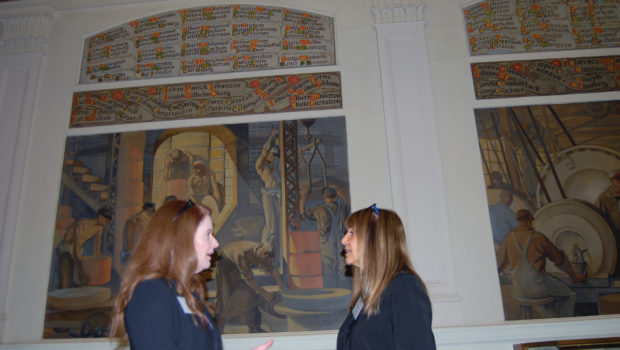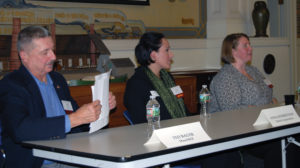WORCESTER – Three experts found commonality inside Saint-Gobain’s historic North Hall Oct. 27, 2016 while examining ways to attract the next generation of manufacturing workers.
Currently, Massachusetts’ manufacturing companies enjoy a 67 percent increase in new job creation. Also, these statistics include a 71 percent increase in the number of new hires, 63 percent increase in sales, and 79 percent increase in cost savings. Manufacturing in Worcester is now the strongest sector in comparison to Boston, as shown in the most recent census. Across Worcester County, 31,279 people now enjoy manufacturing careers. Additionally, nearly 10,000 people possess manufacturing jobs inside Worcester city limits. Statewide, 300,000 people work in manufacturing but much of that same workforce is also nearing retirement age.
Experts define bright future for manufacturing
Worcester and Central Mass. parallel a manufacturing workforce gap nationally with more than 2 million vacant jobs within the next decade. At least 100,000 of those vacancies will arise here in Massachusetts by 2020. A 2014 UMass Dartmouth survey finds that one in three Massachusetts manufacturers reports having a difficult time hiring production workers. That influences organizations such as the MassMEP to continue developing new methods and training for future workers.
“Manufacturing is fourth among the top employers in this region,” says Timothy P. Murray, president and CEO of the Worcester Regional Chamber of Commerce. “The average annual wage in Central Mass for manufacturing is $60,000 and statewide $75,000. If we don’t refill that workforce pipeline, companies have options where they can locate, grow and invest. So it’s in our best interests to make sure we are giving young people and those needing re-training those opportunities.”
REBRANDING MANUFACTURING
Ted Bauer, director of workforce development strategies at MassMEP, says this severe workforce shortage needs the immediate and collective attention of employers, colleges and technical-vocational schools. He feels they need to re-brand manufacturing as a career pathway that is more advanced and technology-based today.
“There are multiple pathways for employees that might have very different interests,” says Bauer. “Today, the bar is high. There is more brain than brawn now.”
MACWIC leads employer-led workforce training
Manufacturing Advancement Center Workforce Innovation Collaborative (MACWIC) on Grove Street in Worcester is now the statewide focal point for employer-led workforce training. “When our people retire, they leave with them a lot of knowledge,” Bauer adds. “Some of that knowledge can’t be replaced. MACWIC has 235 company members that represent 19,000 employees and $9 billion in sales. We tackled retraining incumbent workers, we communicated with vocational technical schools about what was important for recruiting new workers. Now we have a pathway and connected it to apprenticeships and college credentials. You can start on the shop floor and work your way to an associates’ degree.”
Saint Gobain makes it fun to ‘make cool things’
Nicole Zea, plant manager of superabrasives at Saint-Gobain, says her company tries to stress to new and future employees that it can be really fun and rewarding making cool things for a living. Additionally, she says that there are a lot of different entry points today.
“For us, you start at the shop floor level,” Zea says. “A lot of what we do is on-the-job-training for those who want to do work with their hands in materials sciences like putting together a mold, filling that mold, and then making a solid from there. What are the physical properties that drive that?”
Also, Zea adds that “watching sheet steel be pressed at thousands of tons of pressure at 12 miles an hour through a factory and my wheel is grinding the side of that to make sure its surface is as shiny as possible for that kitchen countertop you’re making is a really interesting connection to make. This all starts back at raw materials.”
Administration roles also in demand
According to Anna Robertson, human resources manager at Eaton Corp. Customer service, human resources and administrative roles are also in demand. She recommends that new applicants really think long and hard before and during a job interview about whether that potential role fits their own personality, acquired soft skills, and family needs. “I think people don’t always realize that they have options. Additionally, it’s important that you align with the company. Also, what can you offer the company and what sets you apart? My biggest question in job interviews is why would I pick you? The job has to be something you are truly passionate about and truly believe in.”
To learn more about manufacturing training and employment opportunities in Worcester and Central Mass., visit www.macwic.org, www.massmep.org and www.qcc.edu.






